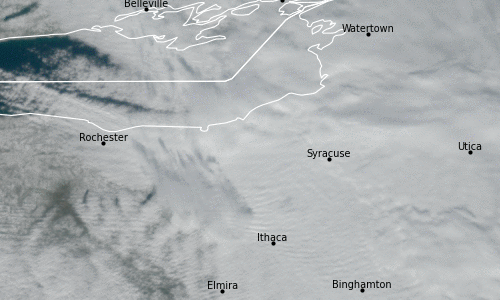
At 12:08 p.m. (ET) on Wednesday, Dec. 2, 2020, the Geostationary Lightning Mapper (GLM) onboard the GOES East satellite detected an atmospheric anomaly over upstate New York at the same time that dozens of witnesses from Ontario, Canada all the way to Virginia reported seeing a bright flash in the sky. Some people closer to the event even heard its associated sonic boom.
This disturbance was a meteor that burned up in the sky as it streaked overhead. If any part of it had reached the ground, it would have been called ameteorite. According to NASA's Meteoroid Environment Office, it clocked speeds of 56,000 mph before it disintegrated roughly 22 miles up.
The event was captured by cameras on the ground:
ICYMI: Did you see it? Hear it? A fireball streaked across the sky Wednesday creating this bright flash (in the middle of the day) in Toronto! Video courtesy @EarthCam Story: Weather Nation TV https://t.co/Dbldi9Kc0J
- WeatherNation (@WeatherNation) December 3, 2020
Is it a bird? Is it a plane? Is it a meteor?At the same moment in time, our cameras that face the CN tower in Toronto caught this object. We're not sure what it is or whether it is related. Follow the red circle and you tell us! Comment below! @TourCNTower https://t.co/NCsY9DHFX2
- EarthCam (@EarthCam) December 2, 2020
The sonic boom also drew attention:
Did you hear it?
A loud sound described as a 'boom' rattled parts of upstate New York on Wednesday! The sound is believed to be a 'likely' sonic boom caused by a meteor passing by! #NYwx #Meteor #Space https://t.co/GVEObd3qCX
- WeatherNation (@WeatherNation) December 3, 2020
While designed for mapping lightning flashes, the GLM can observe large meteors anywhere throughout its coverage area. The instrument takes 500 images of Earth every second, allowing it to measure the shape of a meteor's "light curve" or the change in brightness of a meteor with time, with millisecond precision. In order for the GLM to detect these flashes, the bolides need an apparent visual magnitude of minus 14 at night, which is slightly brighter than the full moon. Learn more about how GOES satellites can track meteors.
The GOES East geostationary satellite, also known as GOES-16, keeps watch over most of North America, including the continental United States and Mexico, as well as Central and South America, the Caribbean, and the Atlantic Ocean to the west coast of Africa. The satellite's high-resolution imagery provides optimal viewing of severe weather events, including thunderstorms, tropical storms, and hurricanes.
